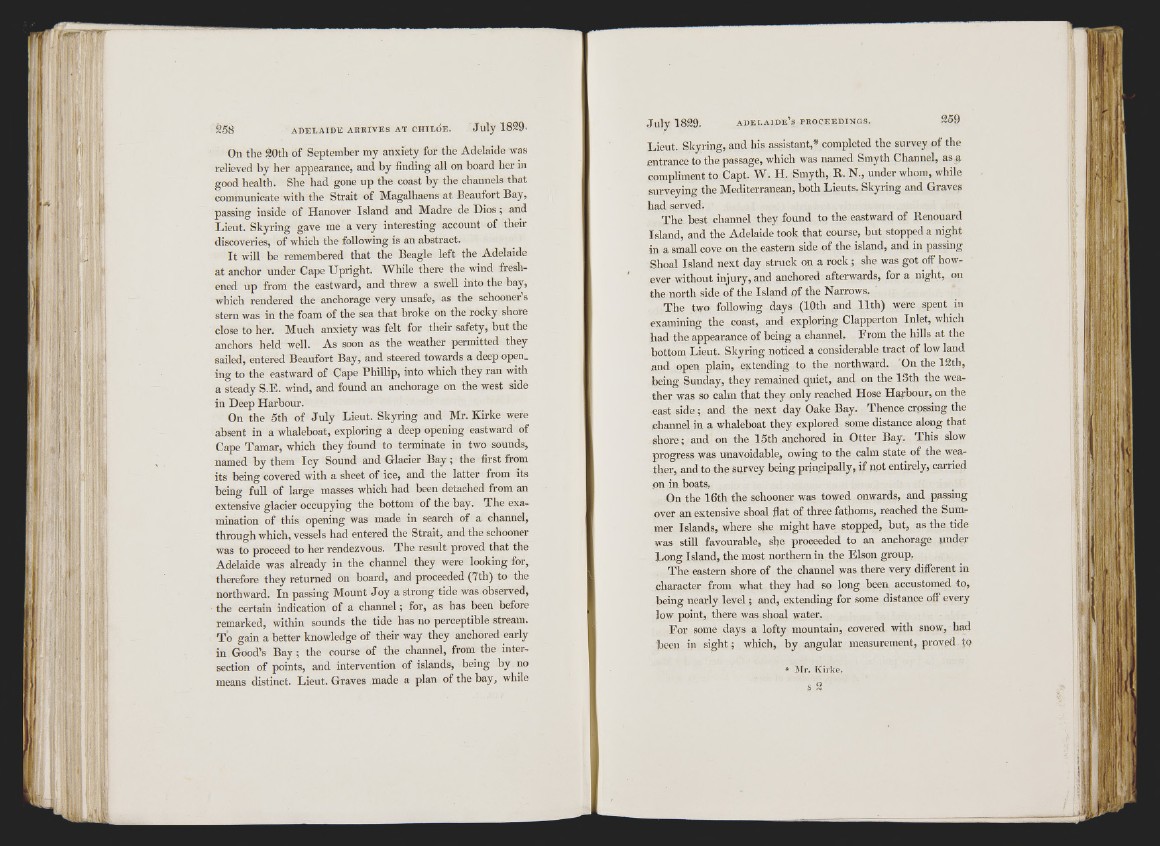
&I-. 'ti
!f*
W i ;
:■ • rH :
f f 4 i
Ì i ' i
I ,flf
7^
ii
. i t o l i to i'
i | i ; :
Ji l : ;
• - ■. .7
7' '7
On the 20th of September my anxiety for the Adelaide was
relieved by her appearance, and by finding all on board her in
good health. She had gone up the coast by the channels that
communicate with the Strait of Magalhaens at Beaufort Bay,
passing inside of Hanover Island and Madre de D io s; and
Lieut. Skyring gave me a very interesting account of their
discoveries, of which the following is an abstract.
It will be remembered that the Beagle left the Adelaide
at anchor under Cape Upright. While there the wind freshened
up from the eastward, and threw a swell into the bay,
which rendered the anchorage very unsafe, as the schooner’s
stern was in the foam of the sea that broke on the rocky shore
close to her. Much anxiety was felt for their safety, but the
anchors held well. As soon as the weather permitted they
sailed, entered Beaufort Bay, and steered towards a deep open,
ing to the eastward of Cape Phillip, into which they ran with
a steady S.E. wind, and found an anchorage on the west side
in Deep Harbour.
On the 5th of July Lieut. Skyring and Mr. Kirke were
absent in a whaleboat, exploring a deep opening eastwai’d of
Cape Tamar, which they found to terminate in two sounds,
named by them Icy Sound and Glacier Bay; the first from
its being covered with a sheet of ice, and the latter from its
being fuU of large masses which had heen detached from an
extensive glacier occupying the bottom of the bay. The examination
of this opening was made in search of a channel,
through which, vessels had entered the Strait, and the schooner
was to proceed to her rendezvous. The result proved that the
Adelaide was already in the channel they were looking for,
therefore they returned on board, and proceeded (7th) to the
northward. In passing Mount Joy a strong tide was observed,
the certain indication of a channel; for, as has been before
remarked, within sounds the tide has no perceptible stream.
To gain a better knowledge of their way they anchored early
in Good’s Bay; the course of the channel, from the intersection
of points, and intervention of islands, being by no
means distinct. Lieut. Graves made a plan of the bay, while
Ijieut. Skyring, and his assistant,* completed the survey of the
entrance to the passage, which was named Smyth Channel, as a
compliment to Capt. W. H. Smyth, B. N., under whom, while
surveying the Mediterranean, both Lieuts. Skyring and Graves
had served.
The best channel they found to the eastward of llenouard
Island, and the Adelaide took that course, but stopped a night
in a small cove on the eastern side of the island, and in passing
Shoal Island next day struck on a rock; she was got off however
without injury, and anchored afterwards, for a night, on
the north side of the Island of the Narrows.
The two following days (10th and 11th) were spent in
examining the coast, and exploring Clapperton Inlet, which
had the appearance of being a channel. From the hills at the
bottom Lieut. Skyring noticed a considerable tract of low land
and open plain, extending to the northward. On the 12th,
being Sunday, they remained quiet, and on the 13th the weather
was so calm that they only reached Hose Harbour, on the
east side ; and the next day Oake Bay. Thence crossing the
channel in a whaleboat they explored some distance along that
shore; and on the 15th anchored in Otter Bay. This slow
progress was unavoidable, owing to the calm state of the weather,
and to the survey being principally, if not entirely, carried
on in boats.
On the 16th the schooner was towed onwards, and passing
over an extensive shoal flat of three fathoms, reached the Summer
Islands, where she might have stopped, but, as the tide
was still favourable, she proceeded to an anchorage under
Long Island, the most northern in the Elson group.
The eastern shore of the channel was there very different in
character from what they had so long been accustomed to,
being nearly level; and, extending for some distance off every
low point, there was shoal water.
For some days a lofty mountain, covered with snow, had
been in sight; which, by angular measurement, proved t(?
* M r . K irk e .
s 2
ij